Effect of Tip Gap Size on the Performance of an Axial Compressor Stage with and without Active Flow Control †
Abstract
:1. Introduction
2. Materials and Methods
2.1. Experimental Facility and Active Flow Control System
2.2. Numerical Set-Up
2.2.1. Presentation of the 2/10 Configurations
2.2.2. General Parameters
3. Results and Discussion
3.1. Reference without Control: Baseline Performance Assessment
3.1.1. Specific Operating Conditions for Ratio R = 0.6% and R = 2.4%
3.1.2. Results from Nominal to Last Stable Conditions at Ratio R = 0.6% and R = 2.4%
3.2. Performance of Flow Control at Different Tip Gap Sizes
3.3. Impact of the Injection Control Parameters
4. Conclusions
Author Contributions
Funding
Institutional Review Board Statement
Informed Consent Statement
Data Availability Statement
Acknowledgments
Conflicts of Interest
Abbreviations
| A | Annulus area at the rotor inlet () |
| Injection angle () | |
| Relative blowing angle () | |
| Density () | |
| Static pressure variation (Pa) | |
| Flow coefficient: (-) | |
| Mass flow rate (kg/s) | |
| Rotational velocity (rpm) | |
| Pressure coefficient: (-) | |
| P | Nominal compressor power (W) |
| Static, total pressure (Pa) | |
| PB | Power balance (%) |
| Global injected mass flow rate (kg/s) | |
| RANS | Reynolds-averaged Navier–Stokes |
| R | Ratio (tip gap size over the axial chord) (%) |
| SBC | Single-blade channel |
| SMI | Stall margin improvement (%) |
| SM | Stall margin (%) |
| Total temperature (K) | |
| U | Rotor tip velocity (m/s) |
| Jet velocity scaled (-) |
References
- Air Transport Action Group. Waypoint 2050. 2021. Available online: https://www.atag.org/ (accessed on 11 June 2023).
- Suder, K.L.; Hathaway, M.D.; Thorp, S.A.; Strazisar, A.J.; Bright, M.B. Compressor Stability Enhancement Using Discrete Tip Injection. J. Turbomach 2001, 123, 14. [Google Scholar] [CrossRef]
- Li, J.; Du, J.; Geng, S.; Li, F.; Zhang, H. Tip air injection to extend stall margin of multi-stage axial flow compressor with inlet radial distortion. Aerosp. Sci. Technol. Elsevier Masson SAS 2020, 96, 105554. [Google Scholar] [CrossRef]
- Marty, J.; Castillon, L.; Boniface, J.C.; Burguburu, S.; Godard, A. Numerical and Experimental Investigations of Flow Control in Axial Compressors. Aerospacelab J. 2013, 6, 1–13. [Google Scholar] [CrossRef]
- Neuhaus, L.; Neise, W. Active Control to Improve the Aerodynamic Performance and Reduce the Tip Clearance Noise of Axial Turbomachines. In Proceedings of the AIAA Aeroacoustics Conference, Monterey, CA, USA, 23–25 May 2005. [Google Scholar]
- Cumpsty, N.A. Compressor aerodynamics. Longman Sci. Tech. 1989. [Google Scholar] [CrossRef]
- Smith, H. The effect of tip clearance on the peak pressure rise of axial flow fans and compressors. In ASME Symposium on Stall; American Society of Mechanical Engineers: New York, NY, USA, 1958; Volume 149, pp. 149–152. [Google Scholar]
- Marty, J.; Castillon, L.; Joseph, P. Numerical Investigations on the Rotating Stall in an Axial Compressor and its Control by Flow Injection at Casing. ASME. J. Turbomach. 2023, 145, 051009. [Google Scholar] [CrossRef]
- Moubogha, J.; Margalida, G.; Joseph, P.; Roussette, O.; Dazin, A. Surge Margin Improvement by Continuous and Pulsed Tip injection. Int. J. Turbomach. Propuls. Power 2022, 7, 10. [Google Scholar] [CrossRef]
- Rannou, C.; Marty, G.; Dazin, A. Effect of Tip Gap Size on the Performance of an Axial Compressor Stage With and Without Active Flow Control. In Proceedings of the 15th European Turbomachinery Conference, Budapest, Hungary, 24–28 April 2023; Paper n.ETC2023-207. Available online: https://www.euroturbo.eu/publications/conference-proceedings-repository/ (accessed on 7 June 2023).
- Veglio, M. Etude Expérimentale et Numérique des Écoulements dans un étage de Compresseur Axial à Basse Vitesse en Régime de Fonctionnement Instable. Ph.D. Thesis, ENSAM, Paris, France, 2016. [Google Scholar]
- Rannou, C.; Dazin, A.; Marty, J.; Tanguy, G.; Castillon, L.; Moughoba, J. Effect of the Axial Compressor Tip Clearance Size: Performance and Transition to Rotating Stall. In Proceedings of the ASME Turbo Expo 2022, Turbomachinery Technical Conference and Exposition (GT2022-80914), Rotterdam, The Netherlands, 13–17 June 2022. [Google Scholar] [CrossRef]
- Cambier, L.; Heib, S.; Plot, S. The Onera elsA CFD software: Input from research and feedback from industry. Mech. Ind. 2013, 14, 159–174. [Google Scholar] [CrossRef]
- Baretter, A.; Godard, B.; Joseph, P.; Roussette, O.; Romano, F.; Barrier, R.; Dazin, A. Experimental and Numerical Analysis of a Compressor Stage under Flow Distortion. Int. J. Turbomach. Propuls. Power 2021, 6, 43. [Google Scholar] [CrossRef]
- Spalart, P.; Allmaras, S. A one-equation turbulence model for aerodynamic flow. In Proceedings of the 30th Aerospace Science Meeting & Exhibit, Reno, NV, USA, 6–9 January 1992; Volume 439, pp. 92–0439. [Google Scholar] [CrossRef]
- Margalida, G.; Joseph, P.; Roussette, O.; Dazin, A. Active flow control in an axial compressor for stability improvement: On the effect of flow control on stall inception. Exp. Fluids 2021, 62. [Google Scholar] [CrossRef]
- Weigl, H.J.; Paduano, J.D.; Fréchette, L.G.; Epstein, A.H.; Greitzer, E.M.; Bright, M.M.; Strazisar, A.J. Active Stabilization of Rotating Stall and Surge in a Transonic Single Stage Axial Compressor. In Proceedings of the ASME 1997 International Gas Turbine and Aeroengine Congress and Exhibition, Orlando, FL, USA, 2–5 June 1997; Volume 4. [Google Scholar] [CrossRef]
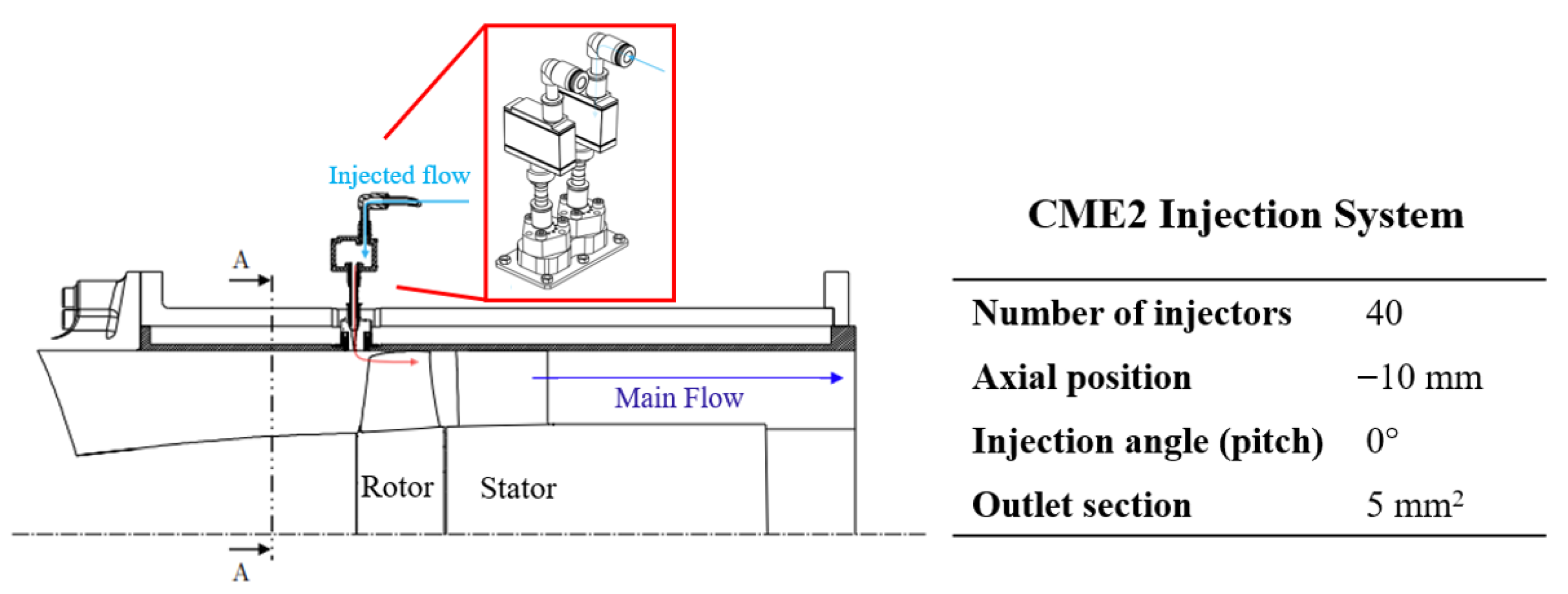

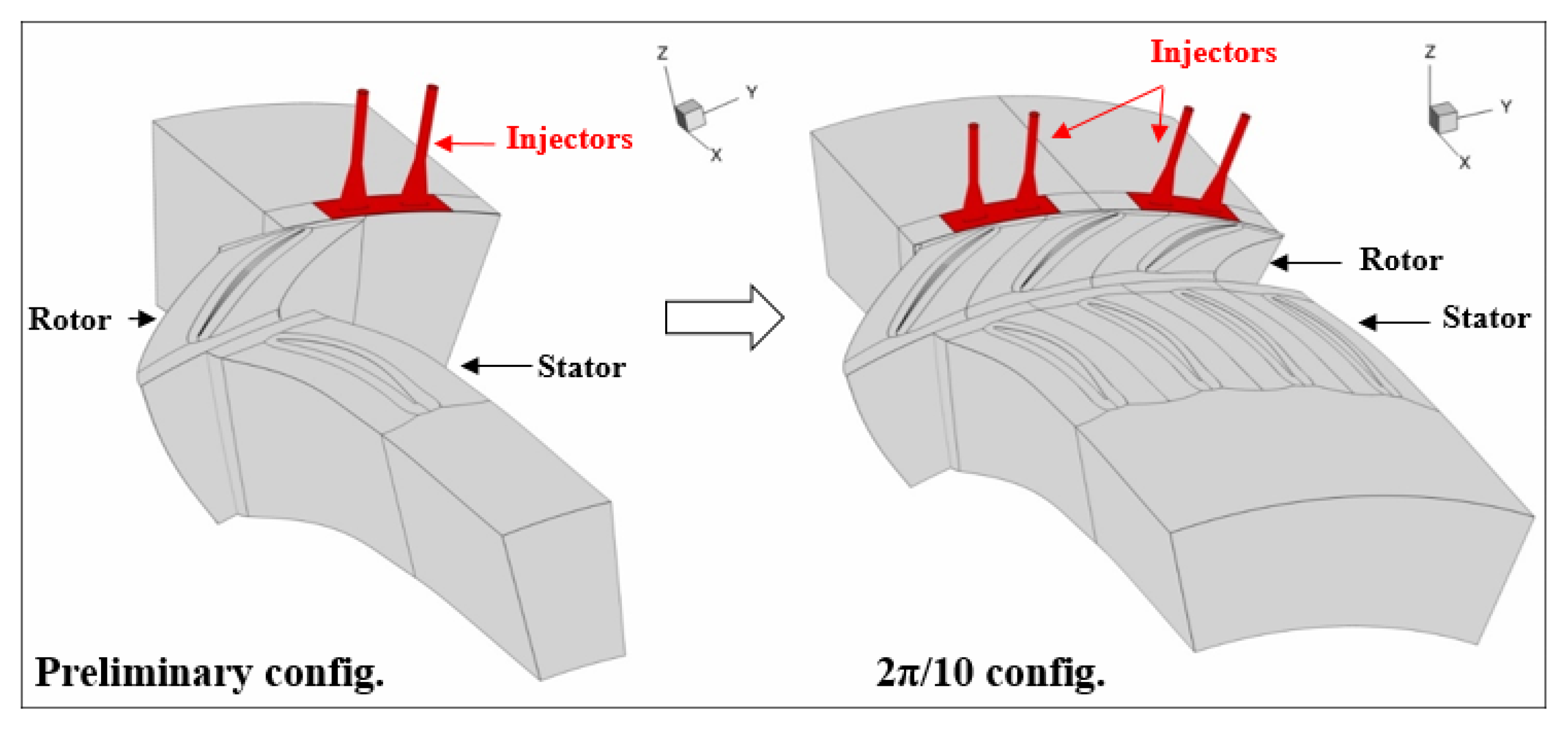
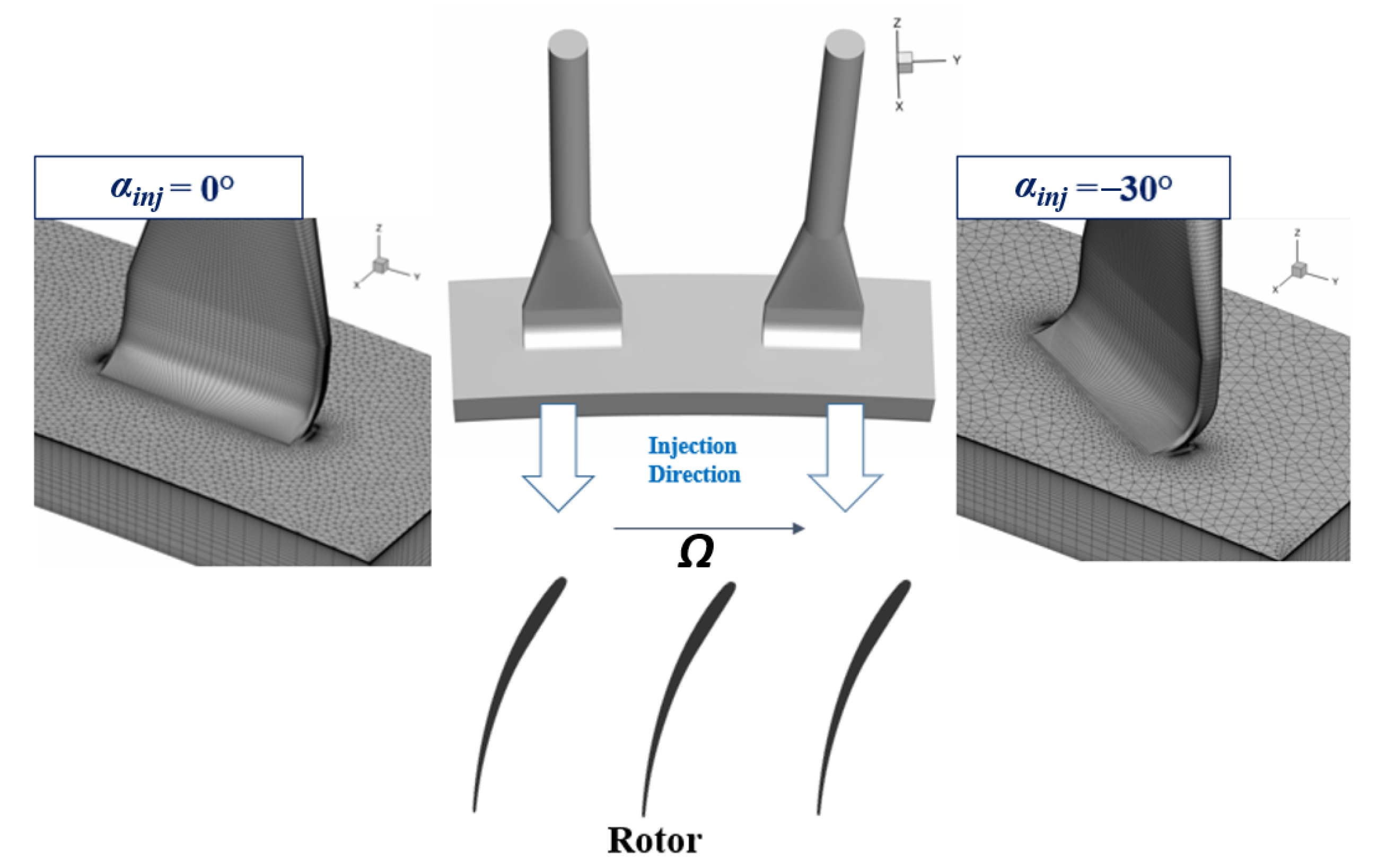
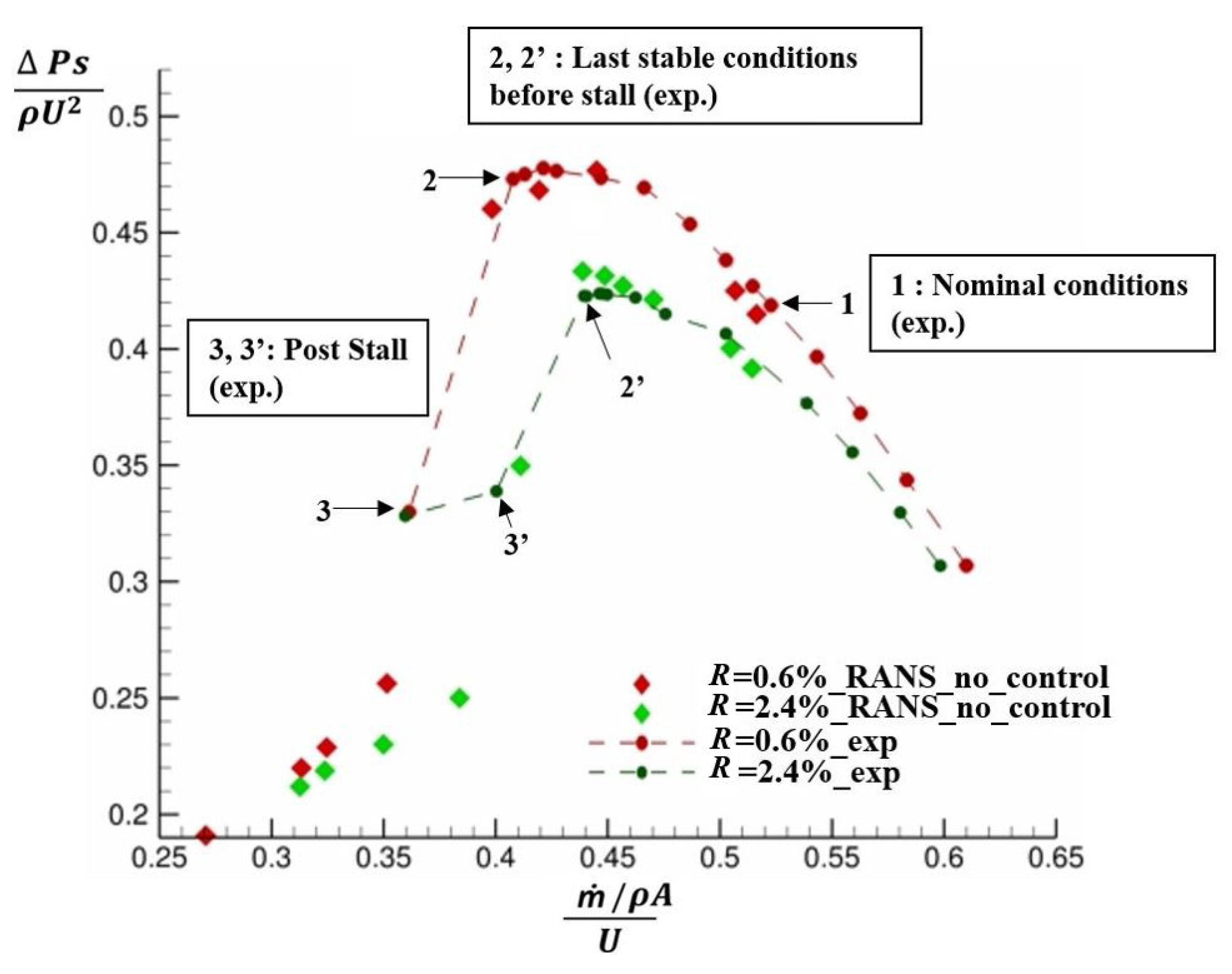
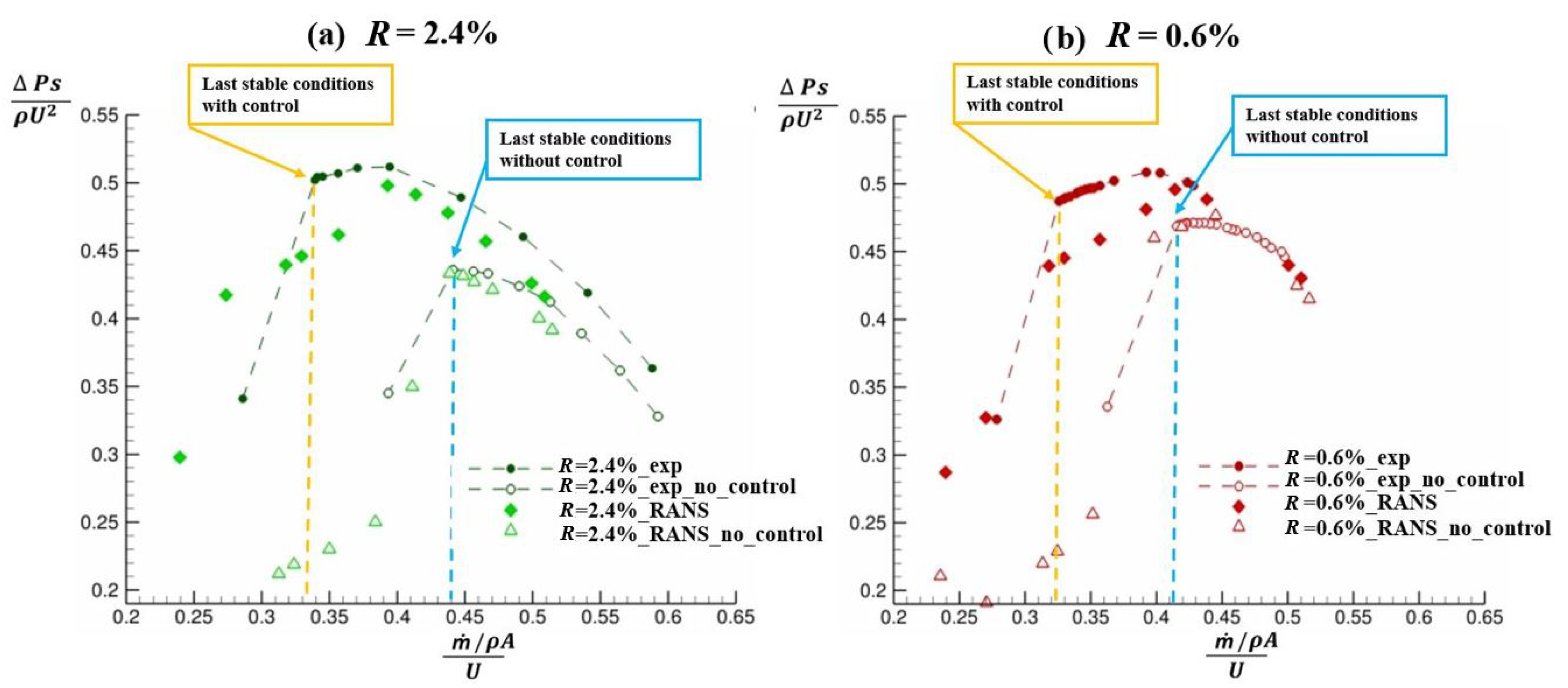
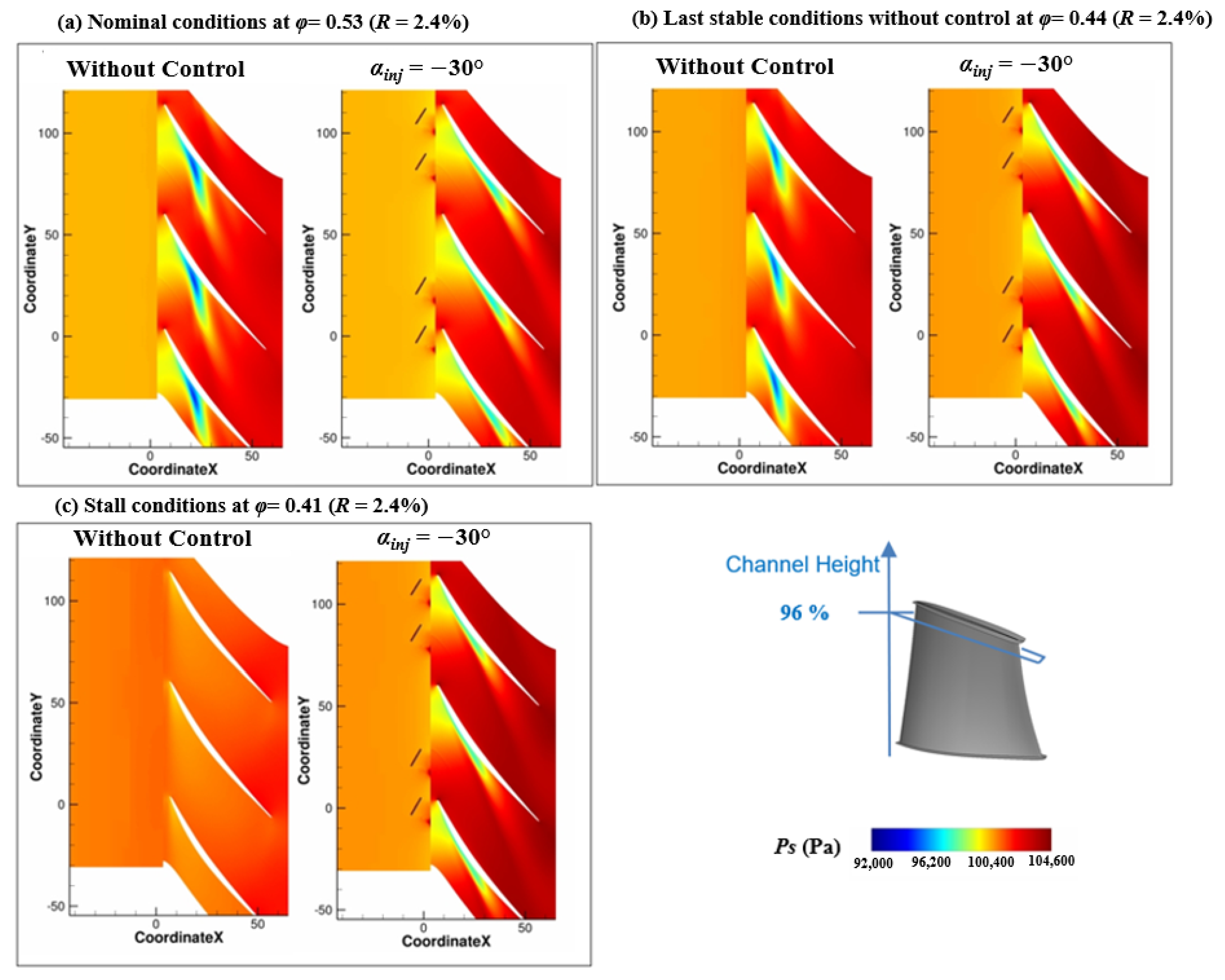
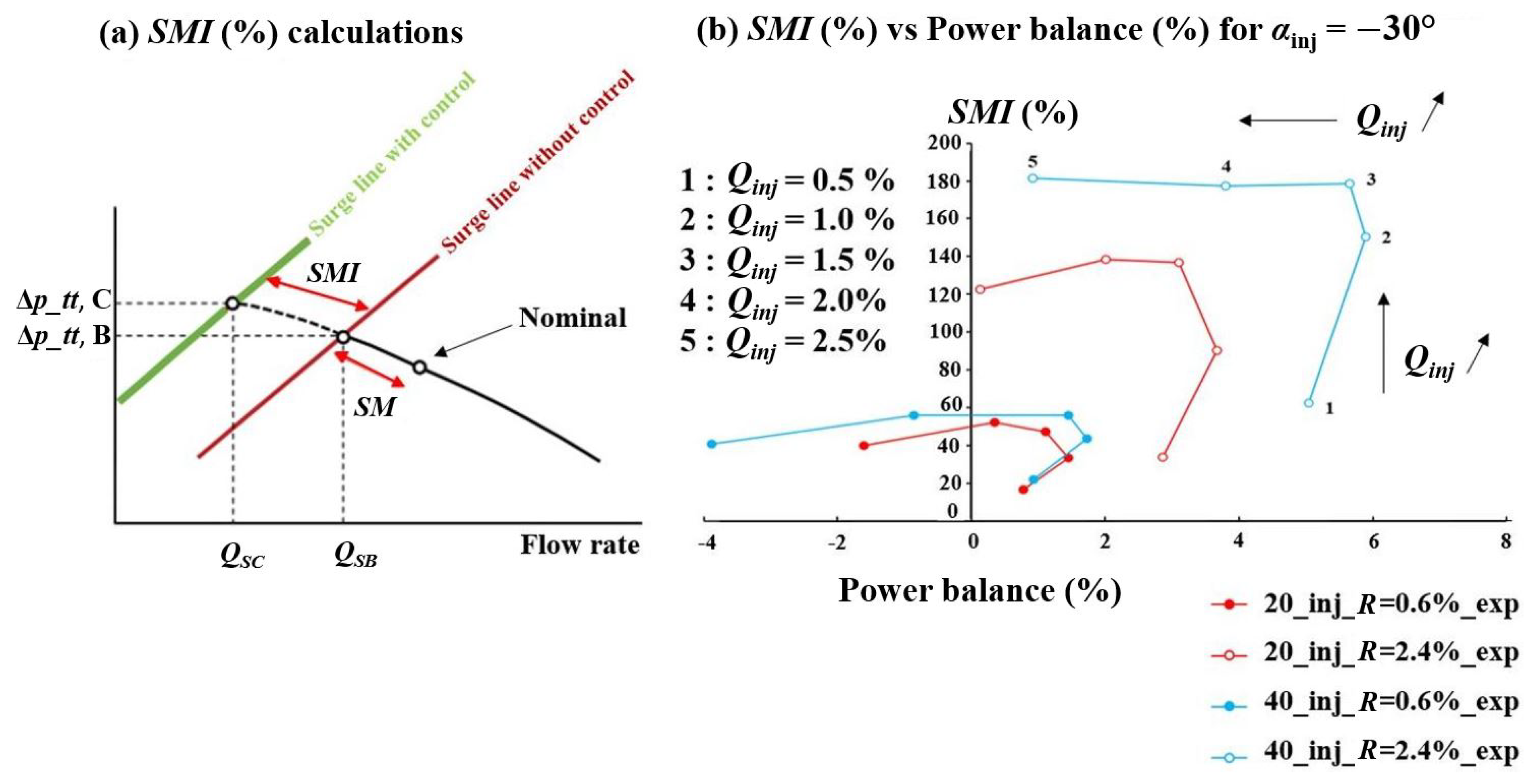
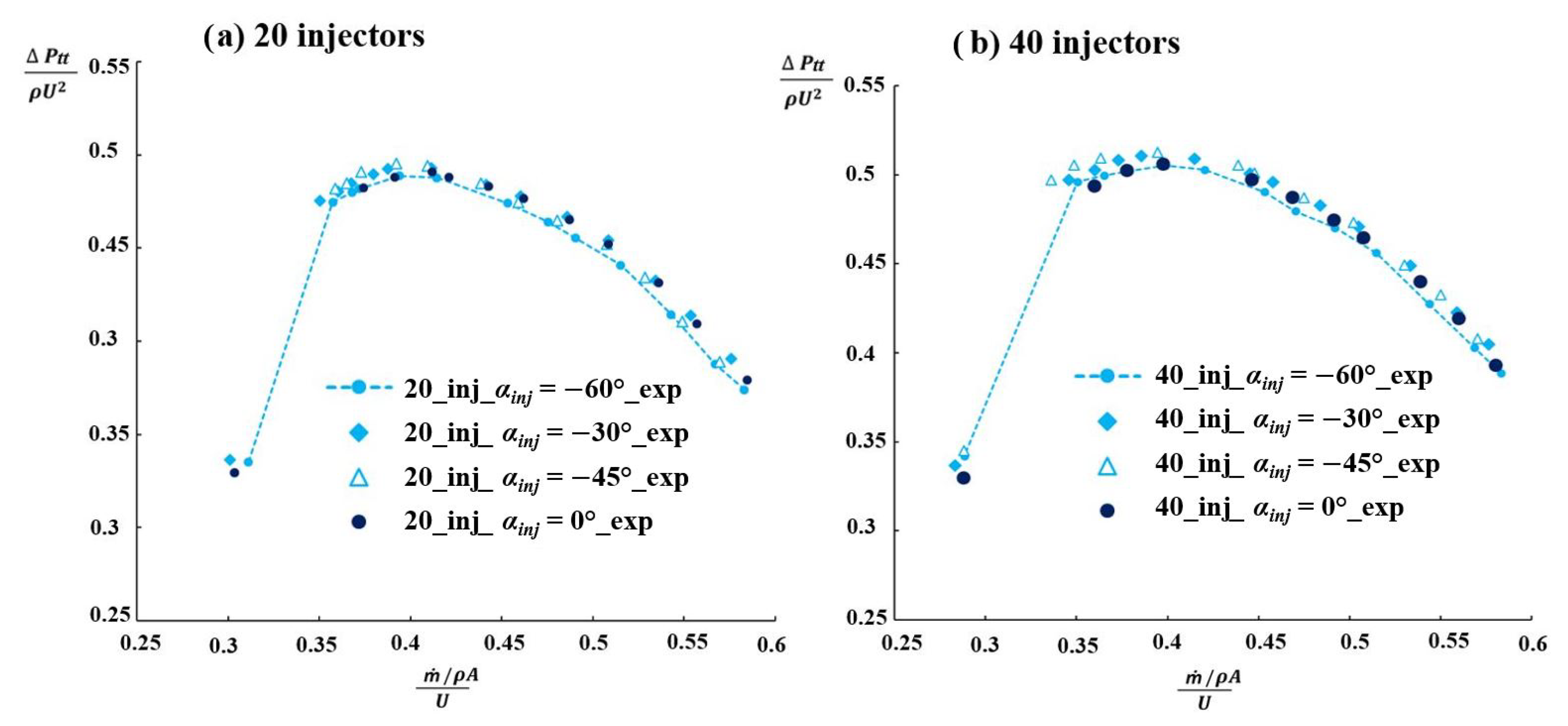
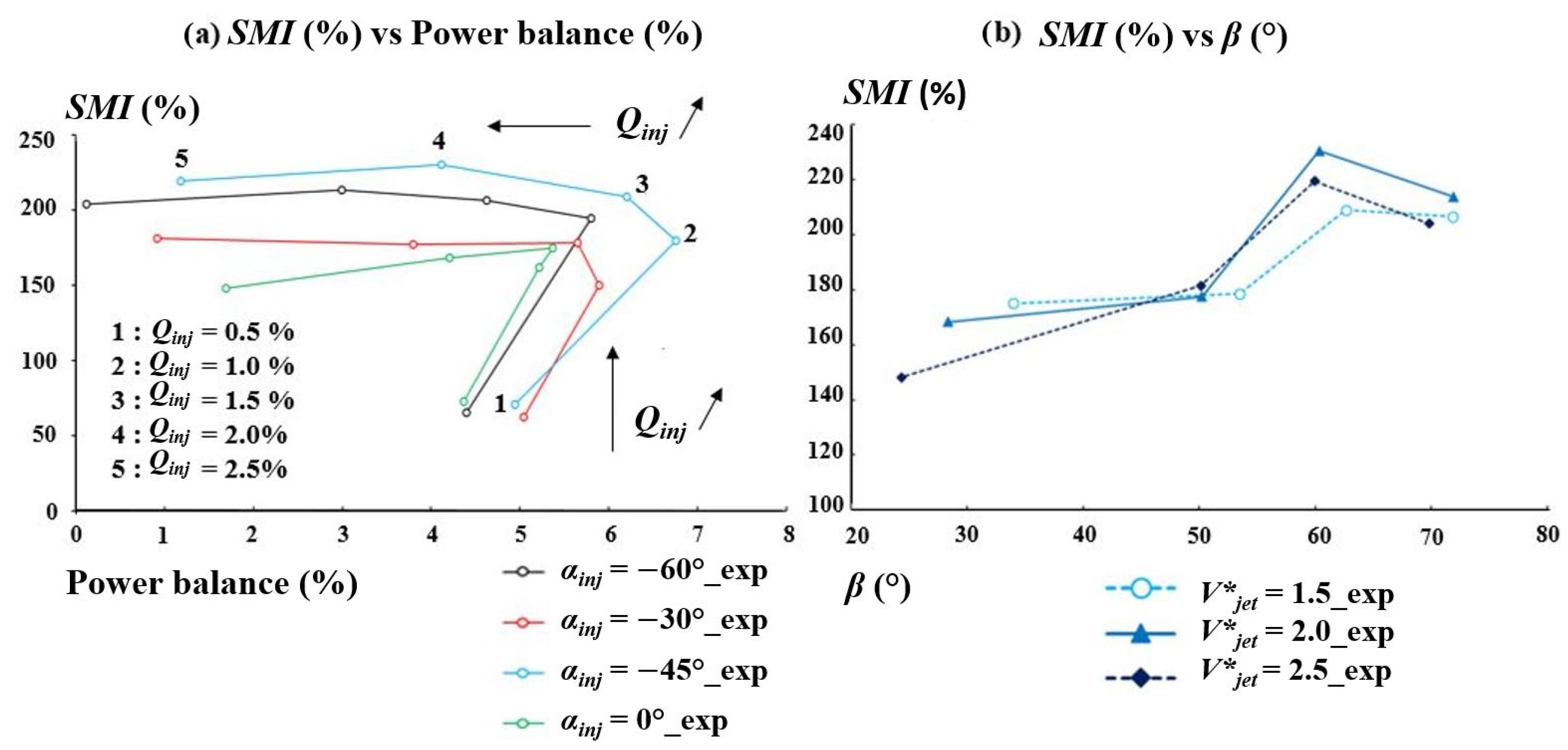
| Upstream | - Subsonic inlet condition with prescribed total pressure |
| - Axial flow direction, = 101,325 Pa, = 288.15 K | |
| Blades, casing, hub | - Adiabatic wall condition |
| - Fixed wall condition for casing and a part of the hub | |
| - Mobile wall condition for hub and blades | |
| Downstream | - Subsonic outlet condition with radial equilibrium using a valve law on static pressure |
| Inlet of the injector | - Subsonic inlet condition with prescribed mass flow rate, |
| - Flow direction normal to boundary, = 288 K | |
| Injector walls | - Adiabatic wall conditions |
Disclaimer/Publisher’s Note: The statements, opinions and data contained in all publications are solely those of the individual author(s) and contributor(s) and not of MDPI and/or the editor(s). MDPI and/or the editor(s) disclaim responsibility for any injury to people or property resulting from any ideas, methods, instructions or products referred to in the content. |
© 2023 by the authors. Licensee MDPI, Basel, Switzerland. This article is an open access article distributed under the terms and conditions of the Creative Commons Attribution (CC BY-NC-ND) license (https://creativecommons.org/licenses/by-nc-nd/4.0/).
Share and Cite
Rannou, C.; Marty, J.; Tanguy, G.; Dazin, A. Effect of Tip Gap Size on the Performance of an Axial Compressor Stage with and without Active Flow Control. Int. J. Turbomach. Propuls. Power 2023, 8, 30. https://doi.org/10.3390/ijtpp8030030
Rannou C, Marty J, Tanguy G, Dazin A. Effect of Tip Gap Size on the Performance of an Axial Compressor Stage with and without Active Flow Control. International Journal of Turbomachinery, Propulsion and Power. 2023; 8(3):30. https://doi.org/10.3390/ijtpp8030030
Chicago/Turabian StyleRannou, Clémence, Julien Marty, Geoffrey Tanguy, and Antoine Dazin. 2023. "Effect of Tip Gap Size on the Performance of an Axial Compressor Stage with and without Active Flow Control" International Journal of Turbomachinery, Propulsion and Power 8, no. 3: 30. https://doi.org/10.3390/ijtpp8030030
APA StyleRannou, C., Marty, J., Tanguy, G., & Dazin, A. (2023). Effect of Tip Gap Size on the Performance of an Axial Compressor Stage with and without Active Flow Control. International Journal of Turbomachinery, Propulsion and Power, 8(3), 30. https://doi.org/10.3390/ijtpp8030030






